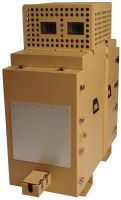
Electromagnetic Interference (EMI) can affect electronics, disrupting timing circuits and corrupting signals. If sufficiently powerful – perhaps a pulse from a nearby radar installation – it can induce damaging voltage surges in wiring. There’s even evidence of EMI damaging the read/write heads of hard drive storage units.
The post Electrical Shielding and Transit Cases explained how a metal enclosure prevents EMI from harming the contents. By forming a “Faraday cage”, the induced electrical charge is kept on the exterior surface, rather than passing through to the inside. However, because metal offers some electrical resistance, and an enclosure needs at least one opening, it’s not possible to block 100% of incident EMI. Nevertheless, careful design and material selection can provide high levels of attenuation.
It’s worth noting that this attenuation works in both directions: EMI generated by equipment inside an enclosure stays inside rather than radiating outwards. This might be an important consideration if it would interfere with other equipment or perhaps be detected by those of hostile intent.
Any metal can provide an electrically conductive outer surface. However, aluminum is preferred for transit cases. Not only is it lightweight and easily formed, its electrical conductivity is excellent. It has one problem; aluminum oxidizes quickly.
Aluminum oxide is non-conductive. This means, as an aluminum enclosure builds up a layer of oxide it becomes harder for EMI-induced electrical charge to spread over the surface. Protective coatings can be applied to prevent oxidation. However, these can wear off over time. As a result, an older aluminum transit case may provide reduced EMI attenuation.
An alternative to aluminum is a non-conductive composite material with a conductive coating. The same problem exists as with aluminum. The coating degrades over time and weakens the ability to attenuate EMI.
Cases have been produced from thermoformed and thermoset materials impregnated with conductive fibers. While this provides some attenuation, the manufacturing process results in high costs. Another method is to insert a metal enclosure inside a composite or polyethylene case. This adds weight and reduces useable volume, however.
EMI can penetrate a transit case, damaging electronics and corrupting data. A new aluminum case can provide high levels of attenuation. Complete shielding cannot be guaranteed without proper engineering and thorough testing. If you’re concerned about EMI, ask Sierra Cases for advice.